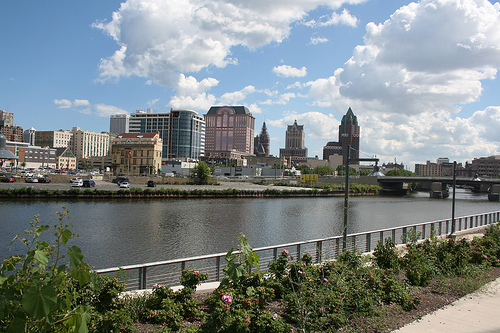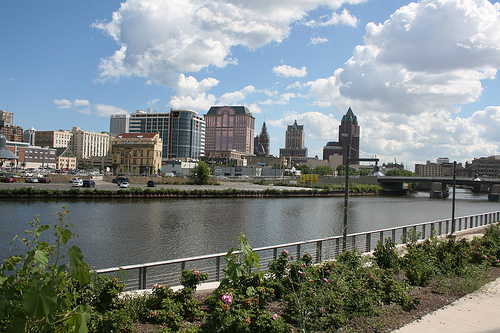 MilwaukeePhoto: Jeramey Jannene
MilwaukeePhoto: Jeramey Jannene
Blog Action Day is an annual event held every October 15 that unites the world’s bloggers in posting about the same issue on the same day with the aim of sparking a global discussion and driving collective action. This year’s topic is water.
For most of history, cities have been unsanitary human death traps, unable to provide the two to three quarts of wholesome freshwater each of us must drink daily to stay alive or the minimum four to five gallons — roughly the equivalent of three to four modern toilet flushes — needed for the most elemental cooking, washing, and hygiene. Urban populations normally restocked only by net influx from impoverished countrysides. Water-borne diseases like dysentery, diarrhea, cholera, typhoid, malaria, and yellow fever have been, far and away, mankind’s deadliest killers.
Cheap, abundant freshwater and good sanitation was one of the key, often forgotten enablers of the demographic transformation that so dramatically increased human population size, longevity, and urban concentration. In 1800, only 2.5 percent of the world’s people lived in cities. Today it’s 50 percent. Projections are that 70 percent of us will do so in the future, even as world population itself surges from today’s 6.7 billion to over 9 billion by 2050.
Yet this next urban evolution cannot occur without crisis unless we reinvent our current paradigm of urban water supply and management to meet the demands of the dawning age of freshwater scarcity. In more and more parts of the world, demand is outstripping available supply of freshwater and water ecosystems are being tapped beyond sustainable replenishment rates. As a result, urban domestic needs are competing for limited supplies against other vital, water-intensive activities such as producing food, energy, and industrial goods. States that cannot feed, power, or provide adequate domestic water to their societies are highly prone to weaken and fail. Just as oil shortages transformed the history of the 20th century, freshwater scarcity is emerging as one of the defining fulcrums of geopolitics, national security, economics, environment, and daily living conditions of the 21st century.
Since none of the silver-bullet technologies, such as desalination, are ready for prime time to provide inexpensive, new supplies in requisite volumes, societies everywhere face the twin challenges of creating a new paradigm that uses existing water resources more productively while allocating sufficient water to sustain nature’s ecosystems themselves. New paradigms have been created before — always with great impacts on the breakthrough-making societies and world history.
The robustness of the Roman Empire was supported by a public water supply that served its largest cities and military garrisons. Its grand, imperial capital of one million people was sustained by eleven gravity-fed aqueducts, covering 300 miles, that brought clean, wholesome water — in amounts comparable to what we enjoy today — to private homes, fountains, and public baths, and continuously flushed away wastes through the city’s extensive sewer network into the Tiber. The seminal urban reform which helped launch the transformation of Augustus Caesar’s famous boast of turning a civil war-ravaged city of brick into a thriving capital of marble occurred in 33 B.C., when Augustus’ lifelong friend, trusted general, and later virtual co-emperor, the plebian-born Marcus Agrippa, took the office of Aedile or Mayor and — at his own personal expense — rehabilitated three decaying aqueducts, built a new one, cleaned out the sewers, and opened 500 public fountains and 170 baths. In the process, he helped establish the modern paradigm of a public municipal water supply, for the poor as well as the rich.
One million people may not seem like many today. But for the intervening centuries after Rome’s fall few cities in the world, and none in the West, ever achieved it again. These were dark ages in which most urban dwellers drank water thick with their own wastes and water beggars went door to door in medieval European cities. The wealthiest obtained cleaner water from the ubiquitous water carrier, mankind’s second oldest profession. Many drank beer or wine or water cleansed by a few drops of vinegar. In China, street vendors since ancient times sold boiling water and hot tea; Europeans took up tea, hot chocolate, and coffee, which were considered medicinal, when they became available after the 16th century voyages of discovery. By 1800, there were only six cities in the world that could support half a million people — London, Paris, Beijing, Tokyo, Istanbul, and Canton. Yet two centuries later, there were 29 metropolises with over 7 million.
The breakthrough that enabled this remarkable rise of modern urban industrial civilization was the mid-19th-century Sanitary Awakening. Seminal reforms occurred in response to London’s Great Stink in the hot summer of 1858 when the Thames River putrefied with backed-up sewage. This struck terror in the hearts of legislators in Parliament — who for decades had been balking at public sanitary reform despite the fact that tens of thousands of common Londoners were dying from cholera and other filth diseases — because at the time conventional wisdom held that diseases were transmitted by bad smells, which of course they themselves could not escape, stuck as they were in the Houses of Parliament on the bank of the river. Motivated by this salutary personal fear they finally passed historic reforms — it took them only one month! London’s modern sewerage system, embankments, and water supply system soon set standards that all industrial nations strived to emulate and surpass in a virtuous circle of reforms.
The Sanitary Awakening gave rise to the 20th century public health revolution, the germ theory of diseases, vaccines and environmental reforms that eradicated many diseases, and the surge in world population and longevity that soon followed. By 1920 the residents of all rich, industrial cities in Europe and North America enjoyed abundant, clean freshwater for drinking, cooking and washing; death from waterborne disease fell sharply in America, and became negligible by 1940. In the second half of the 20th century, centralized wastewater treatment plants became increasingly common to collect and disinfect raw sewage before discharge into public waterways — such discharges today are often cleaner than the water into which they are released.
Today’s freshwater scarcity crisis is closing the final chapter on the urban water paradigm of the industrial era. As water supplies grow scarce and ecosystems deplete, drawing more and more freshwater from ever farther distant sources is increasingly untenable. There are simply not enough good resources, and transporting huge quantities of water — which weighs a heavy 8.3 pounds per gallon or 20 percent more than oil — consumes much costly and often carbon-producing, energy.
A new paradigm shift — to an efficiency model for urban water — is urgently needed. Fortunately, one is starting to emerge in embryonic form from the trial and error experiments of cities around the world. It has two main parameters: First, to get more productive use from each drop of existing supply; second, to do so in ways that help sustain water ecosystems. The new paradigm, it is also increasingly clear, must be based on a holistic understanding of the total workings of each watershed environment — how withdrawals and injections of water affect the size, timing, and quality of flows throughout the ecosystem, for instance — and engineered as an
integrated complement rather than as a series of disconnected, separate tasks.
More and more, the holistic tool kit is utilizing nature’s own ecosystem services — for example, restoring wetland edges and community-friendly urban ponds to absorb flood waters and cleanse pollutants rather than concrete channelization, and re-foresting lands upriver to control sediment flows, slow run-off, and capture more groundwater. Cities like Philadelphia and Chicago are investing billions of dollars in new storm-water management systems that employ pervious concrete, green roofs, and rainwater harvesting to simultaneously capture more water for productive use, minimize polluting run-off, and recharge aquifers. In water-scarce Los Angeles, by contrast, half of all storm water today still rushes off to the sea uncaptured, unused, untreated, and worsening pollution.
Cities and industries are further extending urban water supplies by recapturing and reusing treated wastewater for various uses; while so-called “toilet to tap” won’t be ready for prime time until it overcomes its terrible image problem, it is technically feasible and bound to become more common. Wastewater itself is becoming viewed as a valuable commodity: Heat can be profitably recaptured from waste solids, and phosphates and other raw materials effectively mined from it and recycled. More industrial plants are also building smaller scale, decentralized wastewater treatment and recapture facilities on site to save the energy costs of transporting large volumes to and from centralized municipal plants.
The embryonic, new urban water paradigm, nevertheless, remains fragile and at risk of being stillborn under the weight of formidable impediments. These impediments include the very high cost of replacing old infrastructure, as well as entrenched mindsets, interests, and practices. The paradigm faces an as-yet-unproven roadmap. Fortunately the risk of its failing to catch on is offset partly by the sheer broadness of experimentation going on in far flung cities in China, India, Singapore, Australia, Israel, Europe, and the U.S.
History suggests that those cities and societies that deliver the farthest reaching breakthroughs are likeliest to be rewarded with invigorated economic growth and rising influence. And although re-inventing urban water management solves only one piece of the larger challenges of global scarcity, it is an important piece that leverages water resources for other critical uses like growing goods, producing energy, and making water-intensive goods. It is, moreover, also likely to be a bellwether of how well each nation is responding to the overall, epoch-making challenges of global freshwater scarcity.
America starts out on the quest to pioneer a new water paradigm with many comparative advantages, including relatively ample water resource wealth, good technical know-how, political stability, and manageable population pressures. It has no good excuse not to seize the opportunity to lead the way.



